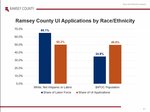



Ramsey County doesn’t want to return to the status quo.
While 2020 was a hard year with unemployment spiking at 11% last May, it brought ongoing workforce disparities to the forefront, and the county responded by passing the Economic Competitiveness and Inclusion Vision Plan in March 2021.
“COVID-19 had brought all the disparities in our community to light and has now given us a chance as a community to be all-in on a comprehensive strategy to build a workforce that is inclusive of everyone. The effort not only benefits residents but will propel our economy for our businesses, as well,” remarked Ramsey County Workforce Solutions Director and Ramsey County Workforce Innovation Board Executive Director Ling Becker.
“We recognize the many unique aspects that make Ramsey County unique. It is a place that is rich in cultural vitality and also economic opportunity.”
According to a report presented to the Midway Area Chamber of Commerce on March 24, Black, Latinx, Asian and Indigenous-owned businesses are growing. However, this growth lags behind other counties.
There is a growing cluster of niche innovation industries regionally, and Ramsey County is positioned to grow within its county limits. The county is seeing a steady and slow industry growth of 8.3% in manufacturing, finance and insurance with much of the growth driven by smaller firms. There is a low business start compared to the region and nation, coupled with low lending. The county has a strength in women-owned firms. Health care is a much larger percentage of economic activity in Ramsey County than in any other metro county and a much higher percentage than the state of Minnesota.
30,700 out of work
In May 2020, there were 30,700 people out of work in Ramsey County, reported DEED labor market analyst Tim O’Neill. The 11% had dropped to an unemployment rate of 5.1% as of January 2021.
But part of that is because the total labor force decreased with many opting not to return to work, including mothers and caregivers. Some elected to retire early. This mirrors state and national trends. The labor force decreased by 13,600 people or 4.6%.
The highest number of unemployed in Ramsey County are its teenagers at 15.4%.
BIPOC, lower-paid workers
affected the hardest
“Ramsey County lost over 43,000 jobs,” said O’Neill, “disproportionately impacting industries with lower wages.”
“Not all industries have been impacted equally,” added RealTime Talent Director of Strategic Research Erin Olson. “A great amount of the unemployed population in Ramsey County are coming out of the lower paid occupations.”
The biggest industries to see job losses were accommodation and food services, along with health care and social assistance; retail trade; arts, entertainment and recreation; and administration. These are jobs that affect the lowest paid workers the most. Plus, 27% of the workers in accommodation and food service who make less than $15 an hour in the industry report as BIPOC.
Overall, BIPOC workers accounted for 35% of the labor force, but 50% of the applications for unemployment. Compared to that, White workers make up 65% of the workforce and 50% of the applications for unemployment. Those with less than a four-year degree were affected at higher rates.
Young people (16-24) and female talent are over-represented in occupations that are experiencing high unemployment during the pandemic.
“Younger workers are more likely than other age demographics to have their jobs impacted by COVID-19 based on concentration in 1) vulnerable industry sectors, 2) the occupations hardest hit, and 3) their lower levels of seniority and work experience,” pointed out Olson. “Younger workers are also less concentrated in jobs that can be done remotely, and more concentrated in high-contact-intensity positions.”
In September 2020, women left the workforce at four times the rate as men.
“Women hold about 93% of all childcare worker roles in Ramsey County as of 2020, and a disproportionately high percentage of that workforce is Black, African American, or Hispanic,” according to Olson. “Low wages and soaring job instability in this sector due to the pandemic threaten the business models of childcare providers of all kinds.”
Plus, two-third of those employed in high contact positions with greater risk of COVID-19 exposure such as healthcare, service and education are women.
Transitioning to remote work was difficult for those in the Midway, Como and Frogtown areas in part because of the lower rates of households with computers and broadband subscriptions in these neighborhoods than elsewhere in the metro area. But also the sorts of jobs meant that while 51% of overall jobs in the county could be done remotely, in the Monitor coverage area only 14% could be remote.
Jobs that need workers, those that don’t
DEED is anticipating a talent shortage where the skills of those seeking work don’t match the jobs available. Ramsey County is working on partnerships between government, community-based organizations and post-secondary institutions to drive re-skilling.
Those fields with a talent surplus and dangerously high unemployment include: cooks, waitresses, bartenders, hostesses, childcare workers, construction laborers, construction equipment operators, painters, cement masons, brickmasons, roofers and insulation workers.
The fields that need more workers than are expected to be available in Ramsey County include: information, utilities, agriculture, finance, pharmaceuticals, and public administration.
Top occupations likely to see shortages in Midway, Frogtown, Como, Downtown, and Rondo neighborhoods are: registered nurses, licensed practical nurses, general and operations managers, management analysts, financial managers, and mental health counselors.
Emerging fields with higher new demand in the Monitor coverage area include: physicians, software developers, HR specialists, software testers, bookkeeping clerks, medical secretaries, and security guards.
“2020 has brought a tremendous amount of uncertainty to our community. However, we also see this as an opportunity and feel an urgent need to address the ongoing workforce disparities in our community. “Returning to the status quo is not acceptable,” said Becker.
She is excited by the county board’s endorsement of the nation’s first Economic Competitiveness and Inclusion Vision Plan. “This framework will guide our efforts over the years ahead as we build an economy where all are valued and thrive,” said Becker.
READ RELATED STORY TITLED
Minnesota’s First Economic Competitiveness & Inclusion Plan implemented in Ramsey County
Comments
No comments on this item Please log in to comment by clicking here